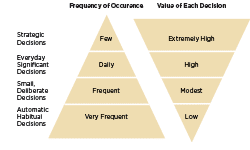Making Quality Decisions
Recently, I moderated a webinar presented by the Society of Decision Professionals. The presenter, Carl Spetzler of SDG, titled his presentation, “Decision Quality for Everyday Significant Decisions–when Decision Professionals will not be Present.” The audience for this webinars was made up primarily (65%) of practicing decision professionals.
We all make decisions many times a day. Most of these are automatic, habitual decisions, like how we get to work. Some are deliberate but small decisions, like where to take a client to lunch. At this level, bad decisions may cause us irritation or embarrassment, but the risks aren’t worth spending a lot of time on the quality of the decision.

We all recognize that strategic decisions are different. Strategic decisions have a particularly large impact, whether due to their scale or their effect on the direction (and even survival) of an organization. Many organizations address strategic decisions with particular rigor, calling on decision professionals to assist in codifying, quantifying and evaluating decision alternatives to identify the best available alternative. Because the risks associated with a poor decision are so momentous, organizations look to decision professionals to help ensure good decision quality.
However, there is an intermediate class of decisions, everyday significant decisions, where the risks of each decision are significant but not momentous. Examples include:
- Major account targeting and planning
- Responses to unexpected events
- Responses to an unhappy customer
- Capital investment decisions below a certain threshold
- Phase-gate decisions in project management
With everyday significant decisions (ESDs), we are often willing to take the risk of making a poor decision and relying on our own decision-making skills. We’ve made these kinds of decisions before, and we judge our own skills as adequate to the task. We don’t regard the potential benefit of improving decision quality as worth the cost of engaging decision professionals for this level of decision-making.
Factors that impair decision-making
However, it’s human nature to miss factors that impair our decision-making abilities:
- We confuse agreement with decision quality
- We are prone to basic cognitive biases and social decision traps
- We become frustrated with decision processes: “Can’t we just get there faster with fewer meetings?”
Thus, we tend to skip over the front-end framing, value clarification, and ideation that create much of the value of decision quality.
- We greatly undervalue opportunity losses
- We exhibit risk aversion even on small risk exposures
- We get attached to our positions and become advocates
What we don’t necessarily see is that we are asked to make so many ESDs in our work that the aggregate cost of poor decision quality becomes very large. If we are habitually leaving half the value on the table in negotiations, missing out on a third of the potential market in our product planning, paying 25% more on average than we need to for materials or labor or acquisitions, and needlessly losing 10% of our customers each year, our business suffers hobbled growth and lost profits. Over 90% of the webinar audience agreed that the value creation opportunity from higher decision quality for ESDs was significant to very big.
Improving Decision Quality
There are two ways to bring more rigorous Decision Quality to ESDs. First, decision makers can learn the particular skills and techniques of Decision Quality, so that they can consciously make better decisions. This is a process of education and training, and it requires people to incorporate responsibility for and practice of DQ into their daily working lives.
The second way is to provide Decision Quality tools, such as decision support software, to anyone who may be tasked with making ESDs. Rather than training decision makers to become expert practitioners of DQ, the tools-based approach emphasizes training decision makers to understand when, why and how to use the tools to ensure high decision quality.
Both approaches require that the organization make a cultural commitment to Decision Quality: “That’s the way we make decisions here.” Only with such a commitment will decision makers make a habit of using the more rigorous decision-making skills, processes and tools that lead to higher DQ. Part of that culture is setting rules for declaring when decisions meet the thresholds for being treated as significant or as strategic, and setting clear, separate procedures to follow for everyday significant decisions and strategic decisions.
One advantage most organizations have is that their existing performance dashboards will show the benefits of improved DQ clearly and directly. A DQ emphasis in the sales department, for example, will rapidly impact metrics like customer retention, average deal size, and time to close. These positive impacts will in turn provide evidence of the value of DQ and help drive its acceptance and uptake in other parts of the organization.
You can see Carl’s entire talk here.



